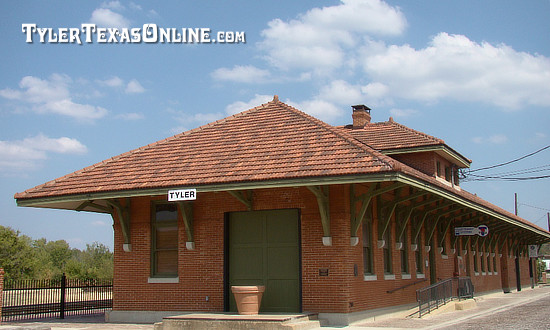 |
Cotton Belt Route in Tyler Texas
Introduction
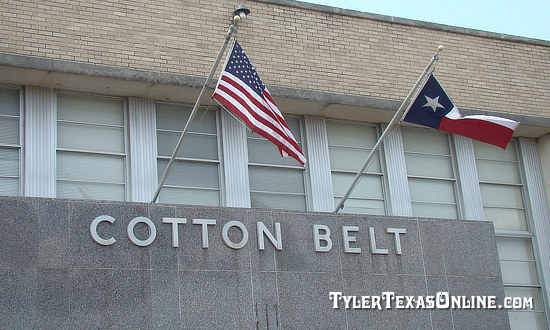 The Cotton Belt Building which housed the general offices of the St. Louis Southwestern Railway, 1517 West Front Street, Tyler, Texas (Tyler Texas Online Staff Photo) |
I have a long association, and fascination, with the railroads of the South. My grandfather Joseph Leo Bourg, Sr. worked for the Rock Island railroad in Alexandria Louisiana, and my uncle Doyle S. Gibson was a civil engineer with the Cotton Belt. Growing up, many of our neighbors were railroad men, and we lived near the tracks of the Missouri Pacific, Texas & Pacific, and the Kansas City Southern.
The railroad, and in particular, the St. Louis Southwestern Railway, has played an important role in business, industry and farming in Tyler and Smith County for over 140 years.
The history of the Cotton Belt is a long, and interesting, one. We will not attempt to document it in detail, as many authors have written excellent, detailed books on the subject, and entire websites are devoted to that subject.
Our interest in the subject started when we first saw the Cotton Belt Building in Tyler, the overpass on Front Street bearing the railroad's name, the depot downtown, the abandoned rail route through Gresham and Flint ... and we wondered how it all fit together. Those sites started our research, and compilation of the story told herein.
We will only present a quick overview of the history of the Cotton Belt from its beginning as the Tyler Tap Railroad, and how it became entwined with the Southern Pacific. We also discuss the 1950s and 60s, when Cotton Belt President Harold J. McKenzie moved the railroad's offices to Tyler, and the Cotton Belt Building on West Front Street was constructed and dedicated. The 75th anniversary of the railroad, in 1952, was likewise a major event with local significance.
Tyler Tap - The Coming of the Railroad to Tyler
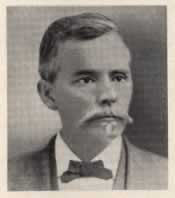 James P. Douglas, Tyler Tap Railroad Founder & President |
After the Civil War, Tyler became a center of agriculture and trade, and residents knew a railroad was the key to economic growth. But Tyler faced economic doom by the construction of two area railroads that were bypassing the city.
The Texas and Pacific Railway Company (T&P) was created by federal charter in 1871 with the purpose of building a southern transcontinental railroad between Marshall, Texas, and San Diego, California. This route was being built to the north of Tyler. The International Railroad and the Houston & Great Northern Railroad (H&GN) were building railways to the south, and later merged to form the International & Great Northern Railroad (I&GN) on September 30, 1873.
Tyler citizens recognized the need to construct a railroad to "tap" either the T&P or the International. One individual in particular took the lead in railroad construction. On returning home after the Civil War, Major James P. Douglas became interested in the fruit industry, and looked for faster means of shipping this commodity outside the Tyler area.
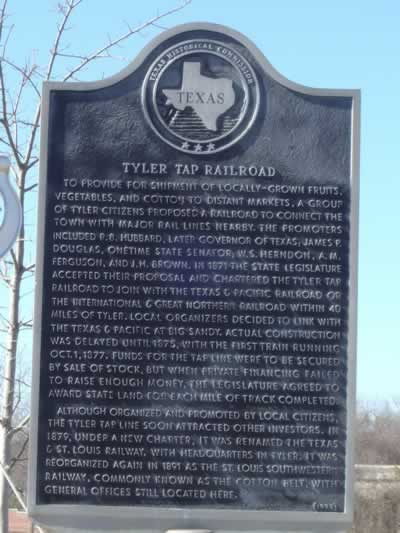 Tyler Tap Railroad Historic Marker in Tyler Texas near the Cotton Belt Depot Museum |
Therefore, in 1870, Douglas petitioned the Texas Legislature to pass a special act of incorporation granting him and others the right to locate, construct, own, operate, and maintain a railroad, for a distance not exceeding 40 miles, from Tyler to connect with another railroad.
The Tyler Tap Railroad Company was thus chartered on December 1, 1871, by a special act of the Twelfth Texas Legislature.
The charter authorized the construction of a railroad from Tyler, in Smith County, to a point no more than 40 miles away, and granted a right-of-way 200 feet wide, as well as the use of any natural resources on state land within five miles of the track. In 1873 the charter was amended to increase capitalization to provide for a route northward through Gilmer, Pittsburg, Mount Pleasant, and Clarksville. This amendment increased the projected mileage to 127. In return for right-of-way, each town was promised a depot located within one mile of their respective county courthouses.
Other railroad activity was occurring at the same time in Tyler, as the Houston and Great Northern completed its line through Tyler in 1873 on its route from Troup to Mineola, a 44-mile branch line between the International Railroad at Troup and the Texas & Pacific (T&P) Railroad at Mineola. The I&GN was merged into the Missouri Pacific (MP) system in 1956.
The charter stipulated that the railroad utilize the same gauge as the railroad to which it was to connect. The T&P was using the standard gauge track. Although $3,000,000 had been authorized for capital stock, less than $50,000 in shares were sold, making it necessary to consider a narrower gauge.
These financial difficulties dictated that a 3-foot gauge be used to economize the project. Construction finally began in the summer of 1875, but it took the company two years to build 21 miles of track to a connection with the Texas and Pacific (T&P) at Big Sandy (originally known as Big Sandy Switch). The connection there between the narrow gauge Tyler Tap and the standard gauge T&P would necessitate the use of parallel siding so that cargo could be transferred from line to the other.
On October 1, 1877, the Tyler Tap's only locomotive, named the Governor Hubbard, steamed into Tyler with the line's first train. The railroad's equipment included one passenger car and sixteen freight cars. The passenger train ran one round trip daily as there was no provision to run the train at night.
Although the Tyler Tap was built as economically as possible, it was not a financial success. Douglas was able to interest James W. Paramore, president of the St. Louis Cotton Compress Company, and his associates, in the Tyler Tap line. The St. Louis capitalists were attracted to the deal as they felt that an additional connection for the Tyler Tap might result in lower rates on cotton.
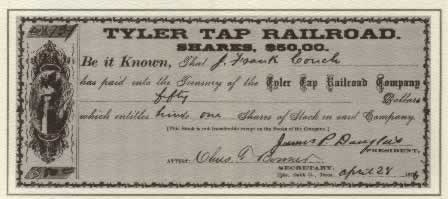 Tyler Tap Railroad Stock Share |
By charter amendment, the Tyler Tap was renamed the Texas and St. Louis Railway Company on May 14, 1879. On July 12, 1880, the company completed 107 miles of narrow-gauge railroad between Texarkana and Big Sandy, and by the end of the year an additional 37 miles from Tyler to Athens. The 38 miles from Athens to Corsicana opened in 1881, and an additional 102 miles between Corsicana and Gatesville in 1882.
The St. Louis Southwestern Railway (SSW), known by its nickname of "The Cotton Belt Route" or simply Cotton Belt, was organized on January 15, 1891. The Cotton Belt later acquired another area railroad, the Tyler Southeastern Railway, in 1899, creating a branch from Tyler through Gresham, Flint and Bullard to Lufkin via Jacksonville and Rusk.
By 1886 the little 21 mile railroad promoted by the citizens of Tyler had become part of a large rail system extending from Bird's Point, Missouri, to Gatesville, Texas. Tyler Tap's place in history as the beginning of the St. Louis Southwestern Railway Company was secured.
Formation of the Cotton Belt Railroad
The St. Louis Southwestern Railway (SSW) had its beginnings traced back to the Tyler Tap Railroad. From Tyler, the railroad expanded into Northeast Texas, thru Arkansas, and up to St. Louis.
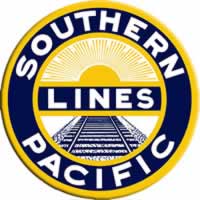 |
Since the St. Louis Southwestern Railway connected with the Southern Pacific in many locations in eastern Texas, the Southern Pacific (SP) Company gained Interstate Commerce Commission approval to control the Cotton Belt system on April 14, 1932.
SP (aka "Espee") continued to operate the Cotton Belt as a separate company until 1992.
While the railroad was controlled by the Southern Pacific, the Cotton Belt maintained its own identity and operations until the early 1990s when it was finally formally merged into the SP system. The railroad also maintained its own paint scheme, although it was essentially a version of the SP livery with SSW markings.
Shown below is a map of the stages of railroad construction over the decades by the Cotton Belt.
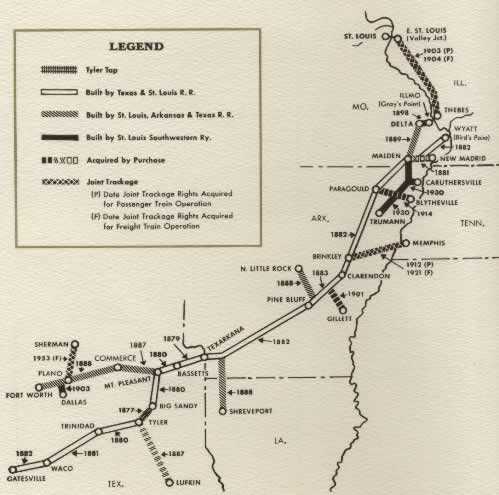 |
Cotton Belt construction history |
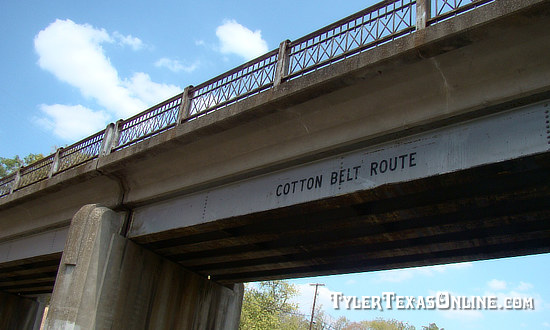 |
Cotton Belt Route overpass on Front Street, Tyler, Texas (Staff Photo) |
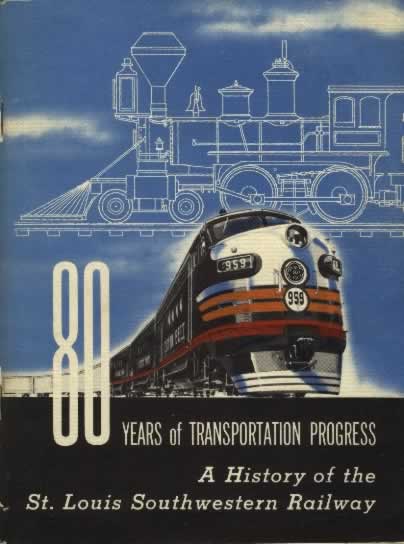 |
Brochure documenting 80 Years of Transportation Progress ...
A History of the St. Louis Southwestern Railway (Reprinted with permission of the Doyle S. Gibson Collection) |
The 75th Anniversary of the Cotton Belt
The Cotton Belt celebrated 75 years of rail service on October 1, 1952. Part of this observance occurred when H. J. McKenzie laid a wreath on the grave of the railroad's founder, J. P. Douglas. Shown below is the Cotton Belt 75th Anniversary Commemorative Cover and enclosed card.
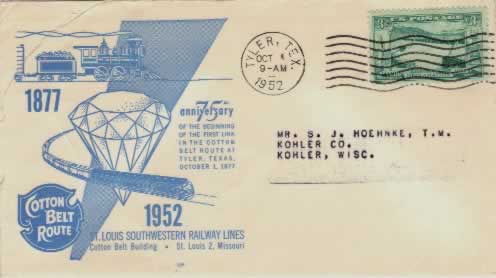 |
Cotton Belt 75th Anniversary Commemorative Cover Postmarked from Tyler on October 1, 1952, celebrating the beginning of the first link in the Cotton Belt Route at Tyler, Texas, on October 1, 1877 (Archives of the author) |
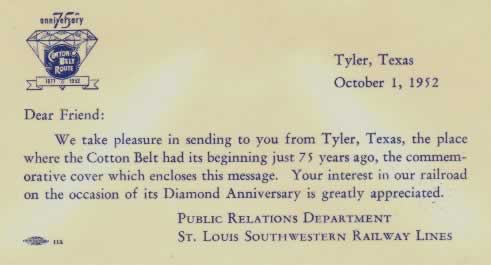 |
Cotton Belt 75th Anniversary Commemorative Card: "Dear Friend: We take pleasure in sending to you from Tyler, Texas, the place where the Cotton Belt had its beginning just 75 years ago, the commemorative cover which encloses this message. Your interest in our railroad on the occasion of its Diamond Anniversary is greatly appreicated". Public Relations Department |
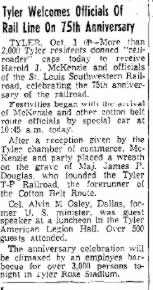 Newspaper article" Tyler Welcomes Officials of Rail Line on 75th Anniversary" |
Newspaper Account of the Anniversary
Tyler Welcomes Officials of Rail Line on 75th Anniversary
TYLER, Oct. 1, 1952
More than 2,000 Tyler residents donned "railroader" caps today to receive Harold J. McKenzie and officials of the St. Louis Southwestern Railroad, celebrating the 75th anniversary of the railroad.
Festivities began with the arrival of McKenzie and other cotton belt route officials by special car at 10:45 a.m. today.
After a reception given by the Tyler chamber of commerce, McKenzie and party placed a wreath on the grave of Maj. James P. Douglas, who founded the Tyler T-P Railroad, the forerunner of the Cotton Belt Route.
Col. Alvin M Osley, Dallas, former U. S. minister, was guest speaker at a luncheon in the Tyler American Legion Hall. Over 500 guests attended.
The anniversary celebration will be climaxed by an employee barbecue for over 3,000 persons tonight in Tyler Rose Stadium.
The Cotton Belt Under Harold J. McKenzie
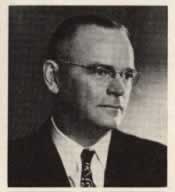 Harold J. McKenzie, President, Cotton Belt Route |
Harold J. McKenzie was a native Texan, and a graduate of Texas A&M University in 1927. Early in his career he was an engineer for the Texas and New Orleans Railroad (T&NO), chartered in 1856, purchased by the Southern Pacific in 1881, and completely merged into the SP in 1934.
McKenzie was sent to the Advanced Management Program at Harvard in 1950, and then to the Cotton Belt as executive vice-president, becoming its president on July 1, 1951.
When McKenzie became president, the Cotton Belt had its general offices in St. Louis and division headquarters in Pine Bluff, Arkansas and in Tyler.
-
The Northern Division, the part of the railroad north of Texarkana, had 964 track miles of main and branch lines and headquarters in Pine Bluff.
-
South of the state line at Texarkana was the St. Louis Southwestern Railway Company of Texas, a Texas corporation, generally called the Southern Division, with headquarters at Tyler and 611 miles of track. Of this total of 1,575 miles of track, about 15% was leased or used under operating rights.
The Cotton Belt Moves to Tyler
 The Cotton Belt Building which housed the general offices of the St. Louis Southwestern Railway, 1517 West Front Street, Tyler, Texas Placed on the National Register of Historic Places in 2005 (Photograph by the author) |
McKenzie immediately began a reorganization of the Cotton Belt, including the merger of the St. Louis Southwestern Railway with the St. Louis Southwestern Railway of Texas. With approval of the Interstate Commerce Commission, the Texas company ceased to exist as an operating property on March 1, 1954.
McKenzie worked quickly to ease any ill feelings within the Texas company. Early in 1953, McKenzie announced at a gathering of all the personnel from the offices in the old Cotton Belt Building at St. Louis, that construction of a new, modern $1.5 million building to house the general offices of the Cotton Belt was going to be built in Tyler, slated for completion in 1954.
He also announced that the company would take necessary steps to make the move as pleasant as possible for those following their jobs to Tyler.
He said that the company would arrange expense-paid week-long visits to Tyler for employees via excursion trains equipped with Pullman cars and diners.
 The first shopping center in Tyler, the Bergfeld Center. opened in February, 1949, expanded in 1954 |
The company would provide assistance in selling their homes in St. Louis. He also promised assistance in locating and buying new homes in Tyler.
Those on the tours were welcomed and treated royally in Tyler by representatives of banks, real estate firms, civic groups, the Tyler Chamber of Commerce and other businesses.
Of the more than 300 employees and their family members who took the trips to Tyler, virtually all chose to make the transfer and become Texans.
They had an immediate positive impact on Tyler's real estate market, shopping centers, banking, retail stores, hospitals and churches.
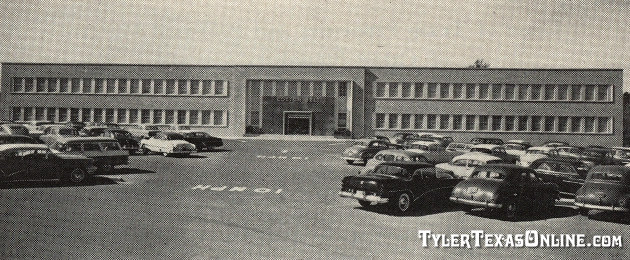 Cotton Belt's air conditioned general office building in Tyler, Texas, seen shortly after dedication in 1955. Costing $1.5 million with equipment, it contained three acres of floor space and boasted a 500-seat auditorium. |
The new building to house the railway general offices, at 1517 West Front Street, was dedicated on March 22, 1955.
McKenzie's Impact on the Cotton Belt
McKenzie grew the Cotton Belt into one of the country’s best run rail companies, and in a span of only 15 years doubled tonnage carried and net income, while reducing the number of employees by half. He also insisted on a high level of safety, and received five significant safety awards, including three gold and two lesser Harriman safety awards during the 1950s and 60s.
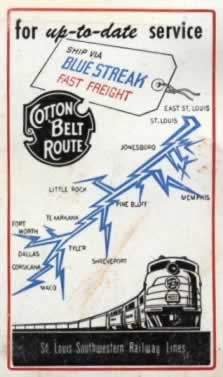 Cotton Belt Rouge Pocket Calendar: For up-to-date service, ship via Blue Streak Fast Freight |
He ushered in the diesel era, and oversaw the finale of the steam engine. The inventory of diesel units from Alco and EMD in 1953 ended the steam era. The final steam run was completed on October 28, 1953, pulled by Number 502, a 2-8-0, which without publicity delivered a work train from Corsicana to Tyler. Passenger service ended on November 29, 1959, as a train on the St. Louis to Pine Bluff route ended decades of elegance.
McKenzie was also instrumental in other dealings, such as securing right-of-way for the Dallas North Tollway; its main plaza was named the “McKenzie Plaza” in his honor.
H. J. McKenzie retired from the Cotton Belt on October 31, 1969, and devoted his talents to civic affairs in Tyler including being a leader in the creation of the University of Texas at Tyler. In 1971, the Texas Legislature approved a bill to create Tyler State College, later renamed Texas Eastern University, and finally UT-Tyler. Mr. McKenzie was appointed Chairman of the Board of Regents for Tyler State College. Other honors include induction into the Texas Transportation Hall of Honor in 2004.
He was succeeded as president by R. Maurice Nall during a time when personnel were being reassigned from Tyler to other locations, and railway decisions were being transferred to Houston and San Francisco as part of SP's policy of gradually reducing the Cotton Belt's autonomy.
Smith County purchased the Cotton Belt building in 1985, and continues to use the building today.
Mr. McKenzie was well traveled, and gave speeches over a number of years in various locations, such at this St. Louis gathering ... see beginning of speech below.
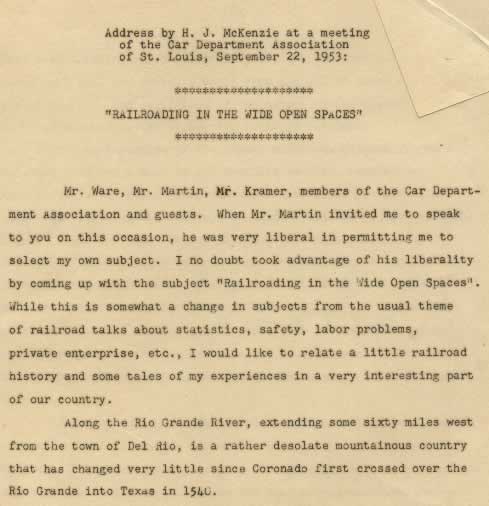 Address by H. J. McKenzie at a meeting of the Car Department Association of St. Louis, September 22, 1953, entitled "Railroading in the Wide Open Spaces" |
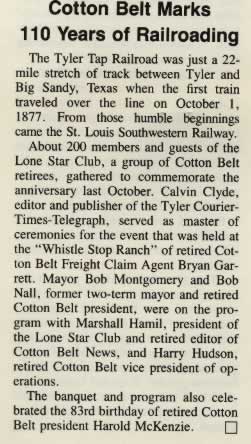 "Cotton Belt Marks 110 Years of Railroading": Article from the Southern Pacific Bulletin, Winter 1987-88 Edition |
Vestiges of the Cotton Belt in Tyler Today
Besides the Cotton Belt Building, another remaining vestige of the glory years of the railroad is the Cotton Belt Depot, today expertly restored and in daily use. And the Cotton Belt's history extends beyond Tyler, to neighboring Texarkana, and Pine Bluff where my uncle Doyle S. Gibson worked for many years as a civil engineer with the Cotton Belt. He was active in the relocation of steam engine #819 to its display in Pine Bluff's Oakland Park, and in the construction of the Pine Bluff Gravity Yard.
The crossing of the Cotton Belt and the I&GN (later MoPac) tracks remains today in downtown Tyler at the site of the Cotton Belt Depot (see photo below).
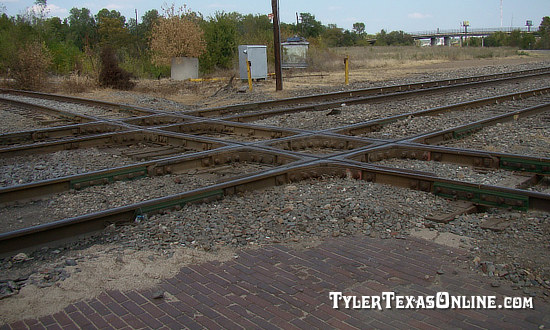 The Diamond, Tower 183, at the crossing of the Cotton Belt and I&GN tracks in downtown Tyler, Texas (Staff Photo, September, 2011) |
We encourage those with an interest in the railroad to visit the Cotton Belt Depot Museum in downtown Tyler and meet and talk to those with a first-hand knowledge of the railroad and its impact on Tyler. And the Smith County Historical Society is always an excellent repository and resource for the history of every aspect of Tyler and Smith County, including the railroad.
And of course it is always interesting to explore the remaining right-of-way of the Cotton Belt branch from Tyler through Gresham, Flint and Bullard to Lufkin via Jacksonville and Rusk.
We recognize the hard work, dedication and service of the men and women of the Cotton Belt, and the fine reputation that they built for the railroad over the decades.
To learn more about the depot and the history of the Cotton Belt in Tyler, we recommend a visit to |
Cotton Belt Menu |
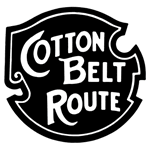 |
